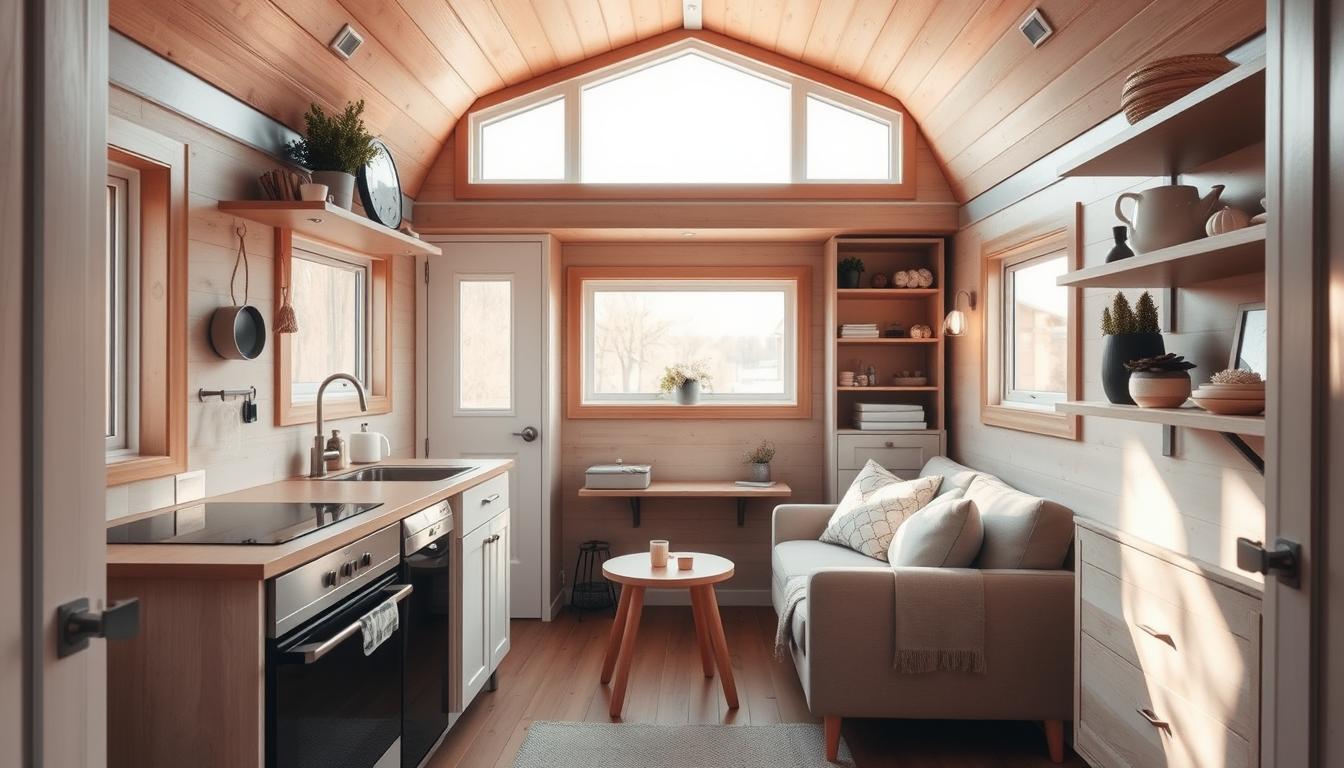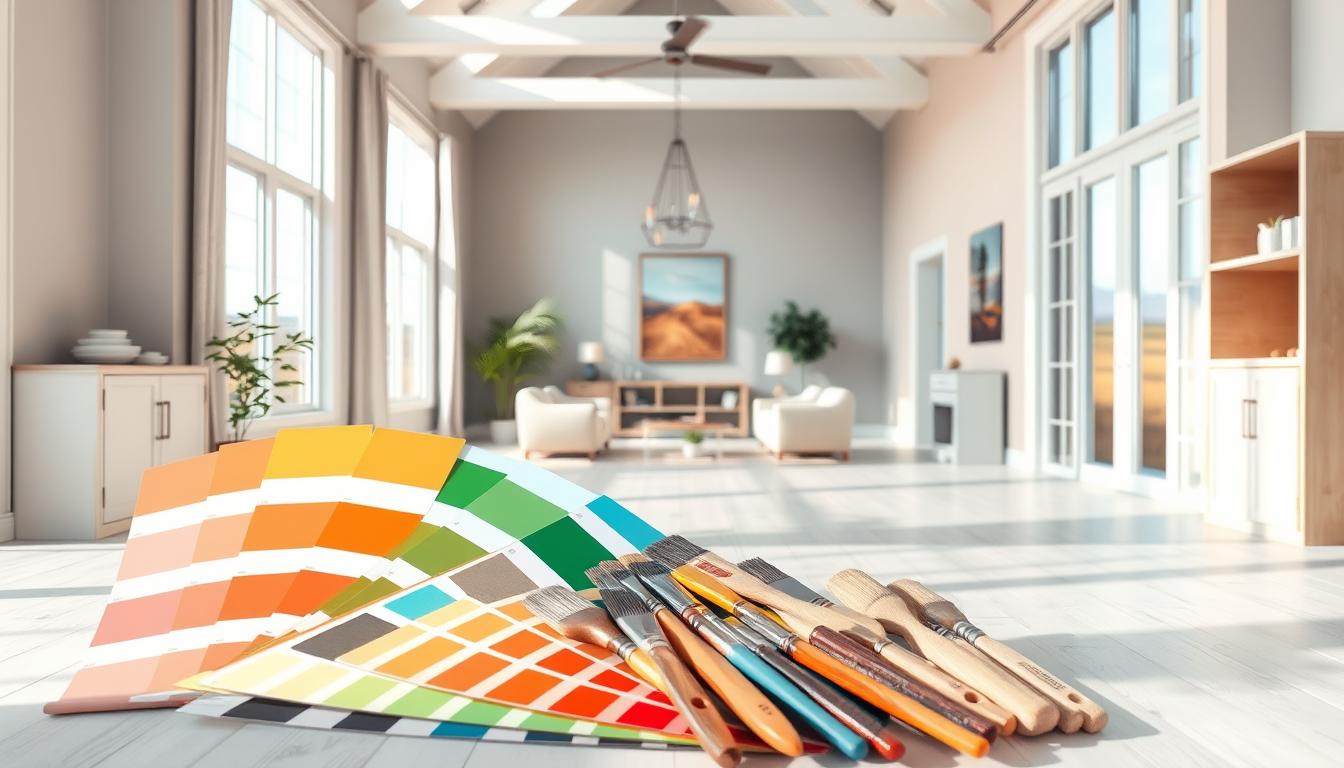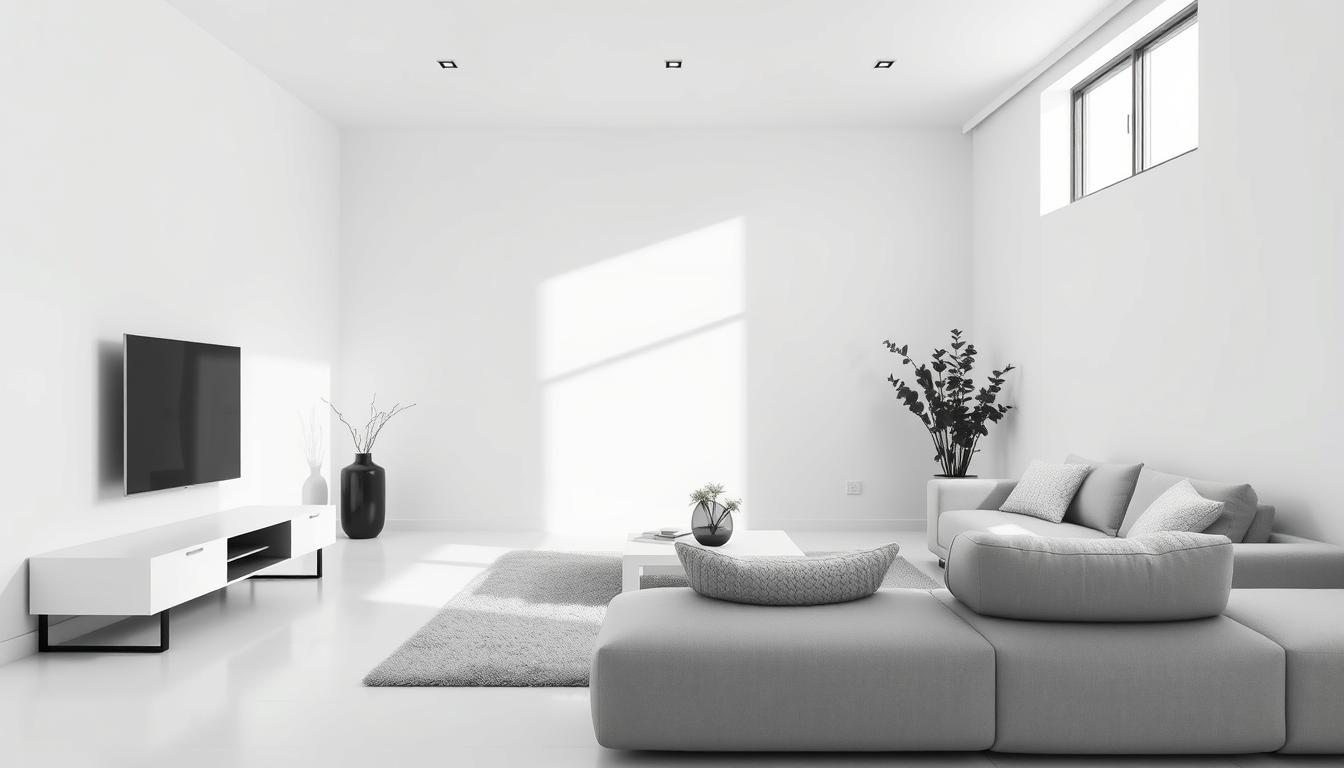With over 10,000 tiny homes built in the U.S. each year, the trend is clear. We’re excited to share our tips on making tiny home interior designs both beautiful and useful.
Creating a french country home interior in a tiny home needs careful planning. We aim to use space wisely and add touches that show your style, like rustic design and cozy vibes.
Key Takeaways
- Maximize space with multi-functional furniture
- Incorporate elements that reflect your personal style
- Use light colors to create a sense of openness
- Opt for storage solutions that are both functional and stylish
- Consider the flow of your tiny home when designing the layout
Understanding the Essence of Tiny Homes
Tiny homes are about living more mindfully. Every item has a purpose. They offer a simpler, sustainable, and fulfilling life.
The tiny home lifestyle values minimalism and efficient space use. By focusing on the essentials, homes feel open and peaceful.
The Appeal of Minimalism
Minimalism is more than a design style. It’s a lifestyle that values what truly matters. In tiny homes, it means making space for what’s important.
“The ability to simplify means to eliminate the unnecessary so that the necessary may speak.” – Hans Hofmann
Using natural materials and elegant simplicity in tiny homes brings calm and connects us to nature. It makes the space beautiful and sustainable.
| Design Element | Benefit |
|---|---|
| Natural Materials | Enhances connection to nature and sustainability |
| Elegant Simplicity | Creates a sense of calm and openness |
| Minimal Ornamentation | Reduces clutter and visual noise |
Space Efficiency
In tiny homes, every inch is precious. Using multi-functional furniture and smart storage makes the space feel bigger.
Good tiny home designs use compact appliances and hidden storage. They also have flexible layouts. These features make the home feel larger and more welcoming.
- Utilize vertical space with wall-mounted shelves and storage units.
- Choose multi-functional furniture that serves more than one purpose.
- Opt for light colors and reflective surfaces to create an illusion of more space.
Planning Your Tiny Home Layout
To get the most out of your tiny home, plan a layout that’s both functional and has a farmhouse aesthetic. A good layout makes your home look great and use space well.
Functional Zones in Tiny Spaces
It’s key to have different zones in your tiny home for cooking, sleeping, and relaxing. Each zone should be designed to do its job well without blocking the home’s flow.
Your kitchen can have small appliances and furniture that does more than one thing. Adding vintage charm, like old fixtures or wood, can make your kitchen unique.
Flow and Accessibility
Good flow and easy access are crucial in a tiny home. Arrange furniture to keep paths clear, making it easy to move around. Use slim furniture and place it against walls to open up the space.
Also, keep your ‘traffic lane’ clear of stuff. This makes your home feel bigger and easier to get around.
Multi-Functional Areas
Using areas that do more than one thing is smart in tiny home interior designs. For example, a sofa bed can be a place to sit and a bed for guests. A storage ottoman can hold things and serve as a seat. These pieces help keep your space tidy and useful.
Think about using walls for storage with shelves or hooks. This keeps your floors and surfaces free, making your home more organized and calm.
By planning your tiny home layout with zones, flow, and multi-functional areas, you can create a beautiful and practical space. Adding a farmhouse aesthetic with vintage charm makes your tiny home truly unique.
Choosing the Right Color Palette
A good color palette can make your tiny home feel bigger and cozier. The right colors can make it feel open, warm, and personal. This makes your tiny home truly special.
Light Colors for Open Feel
Light colors on walls and ceilings make your tiny home feel airy. Light colors reflect light, making the space seem bigger. White, cream, and pale gray are great for tiny homes because they look clean and simple.
To add warmth without losing the open feel, try soft pastel shades or gentle neutrals. These colors bring coziness without making the space feel too full.
Accent Walls for Personality
An accent wall can add personality to your tiny home. Pick a bold, contrasting color that fits your overall look. This creates a focal point, like a fireplace or art piece.
- Choose a color that shows your personality or matches your furniture.
- Think about the room’s natural light when picking your accent wall color.
- Use bold colors carefully to avoid overwhelming the space.
Adding a European touch to your tiny home design is easy with a bold accent wall. Deep blues, emerald greens, and rich reds can make your space feel luxurious and cozy.
By mixing light colors with thoughtful accent walls, you can make your tiny home feel both spacious and cozy. It will show off your personal style and preferences.
Selecting Furniture for Tiny Homes
In tiny home design, furniture choice is key. It’s not just about looks; it’s about making a space that works well. Pick furniture that looks good and does more than one thing. Choose pieces made from high-quality, natural materials.
Compact and Modular Options
Compact and modular furniture is perfect for tiny homes. It lets you use space wisely and change things up easily. Modular sofas and nesting tables are great because they can be rearranged or stored away.
Dual-Purpose Furniture
Dual-purpose furniture is essential in tiny homes. Items like storage ottomans and murphy beds do more than one thing. They help keep your space tidy. Adding rustic design, like reclaimed wood, makes your home feel cozy and unique.
Choosing furniture made from natural materials is smart. They’re good for the planet and make your home feel warm and welcoming. For example, a wooden coffee table can be a centerpiece in your living area.
Here are some ideas for dual-purpose furniture:
- Storage beds with built-in drawers
- Dining tables with storage compartments
- Sofa beds for guest accommodations
By picking furniture that’s compact, modular, and does more than one thing, you can make a tiny home that’s both useful and looks great. Adding rustic touches can make your home even more cozy and inviting.
Maximizing Vertical Space
Effective tiny home designs focus on using vertical space for storage and decor. This approach keeps the space elegant and simple. It also adds provincial decor touches that bring character.
To make the most of ceiling height, we need smart strategies. These not only clear the floor and reduce clutter. They also make the space seem larger.
Shelving Solutions
Shelving is a great way to use vertical space. For tiny homes, choose compact shelving units. They hold essential items without taking up too much space.
- Floating shelves add a modern look and store decorative items.
- Stackable shelves are flexible and adjust to your needs.
- Corner shelves use wasted space, adding storage without taking up floor space.
Hanging Storage Ideas
Hanging storage solutions also boost a tiny home’s functionality. Consider these options:
- Hanging organizers for closets store clothes, accessories, and more.
- Wall-mounted hooks hang kitchen utensils, bags, or even bikes.
- Over-the-door storage racks hold linens, cleaning supplies, or pantry items.
By using these ideas, tiny home dwellers can enjoy a tidy, spacious living area. It will also reflect their personal style.
| Storage Solution | Description | Benefits |
|---|---|---|
| Floating Shelves | Modern shelving units that appear to float on the wall. | Adds a sleek, modern look; ideal for decorative items. |
| Stackable Shelves | Adjustable shelving that can be stacked as needed. | Versatile; can be adjusted according to storage needs. |
| Corner Shelves | Shelves designed to fit into corner spaces. | Makes use of wasted space; adds storage without cluttering the main area. |
Utilizing Natural Light
Using natural light is key in tiny home designs to prevent a cramped feel. It makes spaces feel larger and more welcoming. This is crucial in tiny homes where space is tight.
“As designer Nate Berkus once said, ‘The right light can change the mood of a room completely.'”
This quote highlights the power of natural light in design.
In tiny homes, natural light does more than look good. It creates a sense of openness and airiness.
Windows and Skylights
Windows and skylights are vital for bringing light into tiny homes. Large windows let in lots of light and offer great views. Skylights light up hard-to-reach spots like hallways or bathrooms.
Choose windows and skylights wisely. South-facing windows get more sunlight, perfect for brightening up areas. Also, low-E windows save on heating in winter and cooling in summer.
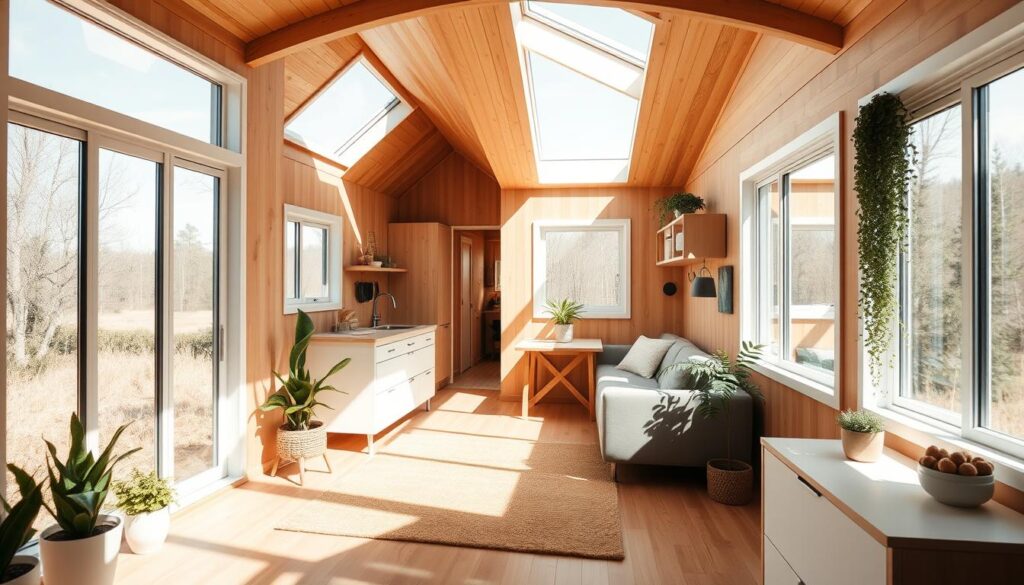
Strategic Lighting Choices
Lighting choices also play a big role in your tiny home’s feel. Mix overhead lights, table lamps, and floor lamps for a cozy effect. For a farmhouse look, pick rustic lighting fixtures for warmth and character.
Adding dimmers lets you adjust light levels as you like. This is handy in tiny homes with multiple uses for the same room.
By blending natural light with smart lighting, your tiny home becomes cozy and inviting. This approach makes your space not only look good but also feel comfortable and relaxing.
Creating an Inviting Atmosphere
In tiny home interior designs, it’s not just about looks. It’s about making a space that feels warm and welcoming. This makes a tiny home feel like a real home.
To make this happen, we focus on two main things: textiles and soft furnishings, and warm lighting. These elements together create a cozy and intimate feel. It makes your tiny home feel like a true home.
Textiles and Soft Furnishings
Textiles and soft furnishings are key in adding vintage charm and European influence to your tiny home. Think about using vintage or vintage-inspired fabrics. This could be antique quilts or classic floral patterns to add depth and character.
Soft furnishings like plush throw blankets, comfy rugs, and inviting pillows also add to the coziness. Pick materials and textures that look good and feel good too.
Warm Lighting Solutions
Warm lighting is vital for a welcoming tiny home. Table lamps, floor lamps, or string lights can add warmth and ambiance. LED candles or fairy lights create a cozy glow without the heat.
It’s important to layer your lighting. Use a mix of overhead, task, and ambient lighting for a warm and inviting glow. This makes your tiny home feel more spacious and welcoming.
Incorporating Smart Technology
Smart technology is a big change for tiny home designs. It makes your home work better and use less energy. This keeps your home looking elegant and simple.
Space-Saving Smart Devices
Smart devices help save space in tiny homes. For example, smart lights can be controlled from your phone. This means no more fumbling for light switches. Smart thermostats also help save energy by adjusting the temperature for you.
For more tips on making your tiny home great, see our guide on tiny home interior design.
- Smart plugs for controlling appliances
- Voice assistants for hands-free control
- Smart storage solutions for better organization
Automation for Convenience
Automation makes life easier with smart technology. You can set your blinds to open and close automatically. Or, your lights can turn on when you’re not home.
| Automation Feature | Benefit |
|---|---|
| Smart Lighting | Enhances ambiance and energy efficiency |
| Smart Thermostats | Optimizes heating and cooling |
| Smart Security Systems | Provides peace of mind with remote monitoring |
By adding smart tech wisely, your tiny home becomes efficient and stylish. It shows off your taste for natural materials. The trick is to mix tech with the natural look you want.
Choosing Sustainable Materials
Using sustainable materials in tiny homes helps the environment and makes living spaces better. As we look into new tiny home designs, it’s key to focus on eco-friendly materials.
When designing your tiny home, pick materials that are good for the planet and look great. Eco-friendly options provide many choices that support green living.
Eco-Friendly Options
Eco-friendly materials are sourced well, have little environmental impact, and last long. Some top picks for tiny homes include:
- Bamboo flooring
- Recycled glass countertops
- Low-VOC paints
- Sustainably sourced timber
These materials make your tiny home healthier and add a special touch to its design. For more ideas, check out our guide to designing tiny homes.
The Role of Reclaimed Wood
Reclaimed wood is a great choice for tiny home interiors. It brings a rustic design and helps reduce waste and new lumber demand.
| Benefits of Reclaimed Wood | Description |
|---|---|
| Unique Character | Reclaimed wood adds a special history and character to your tiny home. |
| Environmental Benefits | Using reclaimed wood cuts down on the need for new timber, saving forests. |
| Durability | Reclaimed wood is often more durable than new wood, having already stood the test of time. |
As the table shows, reclaimed wood has many benefits. It’s a great choice for a sustainable and stylish tiny home.
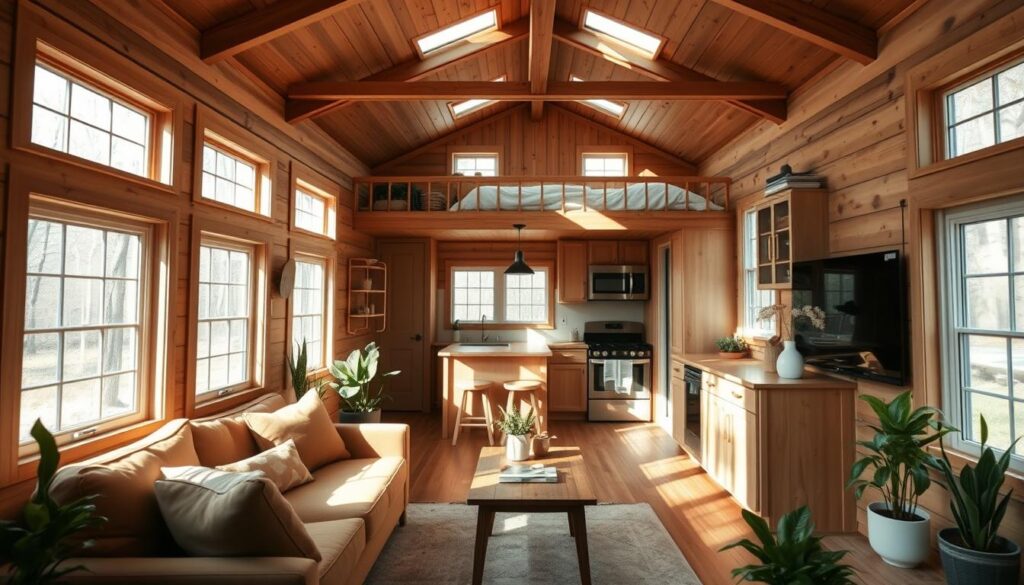
In conclusion, picking sustainable materials is key in designing your tiny home. By choosing eco-friendly options and using reclaimed wood, you can make a space that’s beautiful and eco-friendly.
Personalizing Your Space
Tiny homes let you create a space that’s uniquely yours. It can be filled with character and warmth. We’ll look at how custom art and decor can make your tiny home special.
Custom art and decor are key to adding your personality to your tiny home. By choosing items that show your style, your space will feel like home.
Custom Art and Decor
Provincial decor like vintage items or traditional crafts can warm up your space. Think about adding local artwork or handmade pieces that match your taste.
Reflecting Personal Style
Your tiny home should show off your personal style. It’s about adding things that make you feel comfortable. This could be cozy elements like soft textiles, warm lighting, or special objects that have a story.
By picking decor that speaks to you, you can make a space that’s truly yours.
Outdoor Spaces and Tiny Homes
Outdoor spaces are key in tiny homes. They make our homes feel bigger, even though they are small. This is because outdoor areas can expand our living space.
Outdoor spaces let us live more expansively. We can make outdoor zones that match our tiny home’s interior. For example, an outdoor dining area can extend our kitchen, letting us eat outside.
Extending Living Areas
To make our outdoor spaces bigger, we can blend indoors and outdoors. Using the same flooring or colors inside and out helps. This makes our home feel connected.
Choosing outdoor furniture that matches our indoor furniture is also smart. For instance, wicker furniture outdoors can add a European touch to our tiny home.
Landscaping Tips
Good landscaping makes our outdoor space inviting. We should pick plants native to our area. They need less care and grow well here.
Using plants with different looks and colors is also good. Mixing flowers with green plants adds depth and interest to our space.
| Landscaping Element | Description | Benefit |
|---|---|---|
| Native Plants | Plants that are native to the region | Low maintenance, thrives in local climate |
| Mixed Plantings | Combining plants with different textures and colors | Adds visual interest and depth |
| Outdoor Lighting | Strategic placement of lights to highlight features | Enhances ambiance and highlights landscaping features |
By using these landscaping tips, we can make our tiny home feel bigger. This approach makes our home more charming. It shows a beautiful mix of indoor and outdoor living.
Maintaining Functionality with Style
Designing a tiny home interior that’s both functional and stylish is key. We can achieve this by using multi-functional furniture and clever storage ideas. These elements make our space look great while being practical.
Practical Solutions that Look Great
To add vintage charm to our tiny home, we can repurpose vintage items or use antique pieces. This approach not only brings character but also supports sustainable living.
Balancing Aesthetics and Usability
It’s crucial to balance looks and function when designing our tiny home. We should focus on our needs while keeping the space visually appealing. This way, we can have a tiny home that’s both beautiful and practical.
By following these design principles, we can enjoy a tiny home that’s elegant, has vintage charm, and is highly functional.

